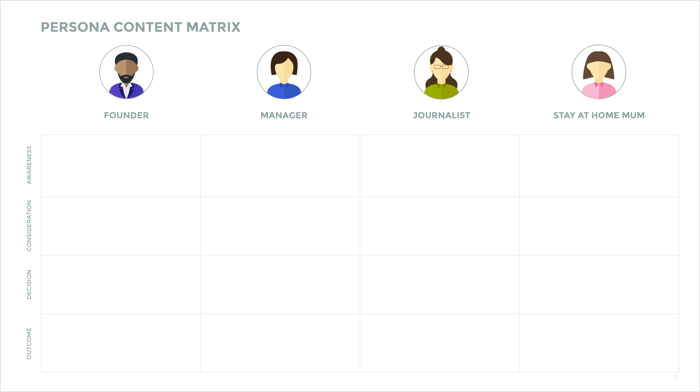How to write quality targeted content
Things to consider when crafting your company's content strategy.
Okay so you’ve got a great idea, product or message to communicate but not sure how it will reach the people you want it to?
Firstly, you’ll need to make sure you do your research about who you should be targeting your message towards and why.
In this blog, we’ll outline how to target the right audience as a business/product owner when creating and distributing internal content.
For PR agents and communications teams, it will help in making sure you pitch the right story angle to the right people, business or organisation.
Understanding your customers/users will help you know who you’re writing for and why.
This way, you’ll have a better chance of getting your message heard, and most importantly, actioned.
about-seed
Do your research first
Who is reading it?
Knowing exactly who is reading your content is a great start before developing your content strategy.
Performing the exercise of Persona Development will allow you to work out the different types of people who you want to target your content and subsequently product or service too. It will also help you to understand what triggers them to read your content and ultimately to make a purchase.
Personas are generally fictional characters that represent the people that use your business, brand, website or product.
For content development, knowing these ‘personas’ can bring alignment and clarity to a team by creating a common language for a team to speak or refer to when developing a robust content strategy.
For example, what type of information would a corporate executive want to hear about your business/message compared to a university student?
Their wants, needs and goals at the present time will most likely be very different. Personas help us to understand them both and how to target our content to them.
Understanding what they might find useful and informative is a great place to start when moulding your content strategy.
For more information on how to create personas read this SEED whitepaper.

Okay, so now you’ve worked out who your customers/users are now you can start angling and shaping your content to those people.
In crafting content there are a number of things you need to consider to purvey your message in a targeted way.
Tone of voice
Tone of voice is an important element to consider when compiling your content.
It’s not about what is said aloud, but rather focuses on the written words.
The words that are chosen and the way they are phrased will determine your company’s tone of voice within all of its written content – including its website, social media, emails and marketing products.
It should be a reflection of your brand and how you want it to be perceived and it should be consistent.
Tone of voice also represents a company’s values and personality, so this must be established before you start writing content.
Keep all of this in mind when constructing your content and remember who you are writing for and how you would like them to perceive you.
You also need to consider how your tone of voice is interpreted by your reader based on their persona.
Know the angle
Finding the right angle for a piece of content is key in getting your message or product heard.
But how do you make sure these people, from various sectors and backgrounds, all hear your message?
As an example, we recently wrote a press release about SEED teaming up with RMIT University’s Fastrack Innovation Program, helping guide students through their design-driven processes.
We analysed the information at hand and looked at the bigger picture when deciding on our angle.
SEED’s involvement with the program was just part of the story – we decided our angle would be that the university was equipping these students with leadership and innovation skills to ready them for the changing workforce they now faced.
The news was, the workforce in Australia was evolving and employers were seeking these new skill-sets in its employees and the uni had identified this.
We knew a smaller angle about SEED teaming up with RMIT probably wouldn’t attract our target market – as people probably wouldn’t care too much about that.
By looking at the bigger picture meant it would capture the attention of people within the technology, education and business sectors.
Okay, so let’s look at who might be reading this and how it could link back to the company.
- We raised awareness for parents of students, students and university-affiliates.
- A corporate executive will have their finger on the pulse for shifts within the business sector, and, they might also be a parent of a teenager.
- Those in the technology and startup fields would also be interested in innovation, like founders and innovation managers.
- Journalists covering these specific rounds (tech, business and education) would also be very interested.
If you feel like one press release wouldn’t target multiple personas, then rewrite the angle (mostly in the first few paragraphs of the press release) for each group and distribute separately.
Ideally, keep in mind your personas when compiling your content – blogs, whitepapers, press releases, Infographic, EDMs and social media.

What is the right channel?
Different people consume content from different channels. This may be a result of their upbinging and level of comfort with technology. It is important to consider how people consume content.
An example of some of the channels are:
- Print Media
- Social Media
- Flyers
- Trade Magazines
- Online Forums
- Websites
- Online News Media
- Billboards
What is the right medium to communicate an idea?
Businesses can use several mediums to convey their information.
- Press release: This is used to gain free publicity for your business or product. A press release can result in multiple published articles about your company and its products resulting in potential new prospects contacting you asking you to sell to them.
- Blog: A blog is an informal piece of content written about a topic of interest. You can include a nice personal touch to blogs, drawing on personal experiences and feelings. It's always informative and useful to the reader.
- Whitepaper: These are very informative, structured 'How Tos' on a specific topic, process or tool. Written as a step-by-step guide, this is usually loaded with diagrams and links.
- Infographic: This is used to convey information or an issue by using mostly images, data and little content, so the reader can quickly digest the information. It's usually one to two pages long.
- Data visual: As its name says, this is loaded with data and images to convey a message and is much more in depth than an infographic.
- Contributed expert column: An expert in a field can write a column on a specific topic to be published by a media outlet.
- Announcement: This is a short piece of content on an internal event or achievement.
- EDM: This stands for 'electronic direct mail' and can be compiled like a newsletter and distributed to your mailing list. It could include internal and external content as well as industry specific news and events.
Where is the reader at in the buying cycle?
You need to understand that each one of your personas moves through several phases towards purchasing a product, service or another outcome.
The diagram (below) shows each persona's progression through parts of customer buying cycle towards an ideal outcome.
Let’s work through three (Awareness, Consideration and Decision) of the seven phases now that relate to content and messaging.

Awareness phase
Targeting appropriate content to people creates general awareness about your company, brand or product.
During the awareness phase, the subject of your content will be aligned with the interests of each persona and may not even mention any of your offerings, products, services.
It is strictly newsworthy content targeted at the wants and needs of each persona. It does however align your brand or business alongside relevant topics.
People in the awareness phase are right at the beginning of the buying cycle and won’t necessarily need anything from you.
Awareness content is the moment when a customer first becomes aware of your product, and it could also be a point where they first become aware of a need that they want to fulfil.
So, it’s about putting the right information in front of them at the right time that aligns your company with their needs and interests, which creates awareness that you may have a solution for their problem down the line.
They are not ready for a hard sell and really, at this point, don't care about your business. It is the wrong timing but creates an association in their mind about your company/product.
Example
Business type: Plant business.
Content subject example: Flower Show next week.
Content types: Event announcement through social media, EDMs.
Example Persona: A 55-year-old+ woman who enjoys gardening.
By announcing and making the Persona aware of the Flower Show, you have also made her aware of your business and positioned your brand in her mind alongside gardening.
Consideration phase
The consideration phase is when a customer/user starts evaluating solutions for their needs.
They are currently looking for your product/service to help solve a problem in their world.
These personas are in need of content that is relevant to their problem and builds reassurance that your business/product is the solution they need.
This is the stage where a prospect Persona develops an increasing interest in learning more about your product and how it can help them achieve their goals.
Example
Business type: Plant business.
Content subject example: BLOG: How we grow plants. Or, an INFOGRAPHIC: Our guide to the right amount of sunlight for your plants.
Content types: Blog, Case Study, Infographic or Data Visual.
Example Persona: Father in his early 40s with a family.
By writing authority content you indicate to the reader that your can solve their problem and give them peace of mind that they will get their desired outcome.

Decision phase
The decision phase is the point where a buyer has determined which product or service best matched their needs, the timing is right and they are ready to purchase.
This type of content could be a promotion or special offer which internally solves their problem and they feel they are getting a great exchange in value.
Example
Business type: Plant business.
Content subject example: Gather ye buds while ye may. Roses – 50% off.
Content types: Promotion.
Channel: Snail mail.
Example Persona: Norm, a 65-year-old retired veteran, who maintains a rose garden.
By writing content about deals and offers for your services in turn solves their problem and they will most likely make a purchase because they feel they are getting great exchange for value.
Knowing your customers will create conversions
The outcome of all this research is understanding how people engage with your content, brand, product or service will ultimately increase sales.
Your content strategy needs to deeply understand the readers' wants and needs and know how to communicate in their language.
The content must also be angled at what they care about.
Last of all, you must have an understanding of where they are in the buying cycle and the right content to offer at the right time.
Related resources:
How to write a press release the media will actually use
Persona Development: The importance of understanding your customers
Want some help on building your startup, growing your business and creating products/services that your customers will love? Contact SEED to make an inquiry.
